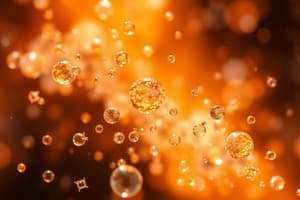Podcast
Questions and Answers
Particles in a solid are __________.
Particles in a solid are __________.
very closely packed
On heating, the particles gain __________ and vibrate more vigorously.
On heating, the particles gain __________ and vibrate more vigorously.
energy
The solid has melted to become a __________.
The solid has melted to become a __________.
liquid
The liquid has boiled to become a __________.
The liquid has boiled to become a __________.
Particles in a gas are __________.
Particles in a gas are __________.
On cooling, the particles lose __________ and move slower.
On cooling, the particles lose __________ and move slower.
The gas has condensed to become a __________.
The gas has condensed to become a __________.
The liquid has frozen to become a __________.
The liquid has frozen to become a __________.
As the particles lose energy, the forces of attraction between them become __________.
As the particles lose energy, the forces of attraction between them become __________.
Particles in a solid are …………………………...gain energy and vibrate in an ……………….
Particles in a solid are …………………………...gain energy and vibrate in an ……………….
Particles in a solid are __________ packed.
Particles in a solid are __________ packed.
On heating, the particles gain __________ and vibrate more vigorously.
On heating, the particles gain __________ and vibrate more vigorously.
When the particles gain enough energy, they overcome the __________ forces of attraction between them.
When the particles gain enough energy, they overcome the __________ forces of attraction between them.
Particles in a liquid are in an __________ arrangement.
Particles in a liquid are in an __________ arrangement.
The particles move __________ past one another in a liquid.
The particles move __________ past one another in a liquid.
On cooling, the particles in a gas lose __________.
On cooling, the particles in a gas lose __________.
The gas has condensed to become a __________.
The gas has condensed to become a __________.
The liquid has frozen to become a __________.
The liquid has frozen to become a __________.
Particles in a solid vibrate about their __________ positions.
Particles in a solid vibrate about their __________ positions.
As particles lose energy, the forces of attraction become __________.
As particles lose energy, the forces of attraction become __________.
Study Notes
Model of Matter: The Particulate Nature of Matter
- Matter is composed of particles that exhibit different behaviors based on their states: solid, liquid, and gas.
Changes of States
-
Melting:
- Solid particles are closely packed in an orderly arrangement.
- On heating, particles gain energy, vibrate, and overcome strong forces of attraction, transitioning to the liquid state.
-
Boiling:
- Liquid particles gain more energy and vibrate more vigorously.
- Eventually, they gain enough energy to become a gas, moving further apart and becoming disorderly.
-
Freezing:
- When cooled, liquid particles lose energy and move slower.
- As they lose energy, the forces of attraction strengthen, and the particles rearrange into a closely packed, orderly solid.
-
Condensation:
- Gas particles are initially far apart and move quickly.
- Upon cooling, they lose energy, slow down, and are pulled closer together, transitioning back to a liquid state.
Key Characteristics of Particle Behavior
-
Solid:
- Particles vibrate about fixed positions and are very closely packed.
-
Liquid:
- Particles are closely packed but can slide past one another, allowing for a disorderly arrangement.
-
Gas:
- Particles are far apart, move quickly and disorderly, with weak forces of attraction between them.
Temperature Influence on States
- Increasing temperature leads to melting (solid to liquid) or boiling (liquid to gas).
- Decreasing temperature results in freezing (liquid to solid) or condensation (gas to liquid).
Model of Matter: The Particulate Nature of Matter
- Matter is composed of particles that exhibit different behaviors based on their states: solid, liquid, and gas.
Changes of States
-
Melting:
- Solid particles are closely packed in an orderly arrangement.
- On heating, particles gain energy, vibrate, and overcome strong forces of attraction, transitioning to the liquid state.
-
Boiling:
- Liquid particles gain more energy and vibrate more vigorously.
- Eventually, they gain enough energy to become a gas, moving further apart and becoming disorderly.
-
Freezing:
- When cooled, liquid particles lose energy and move slower.
- As they lose energy, the forces of attraction strengthen, and the particles rearrange into a closely packed, orderly solid.
-
Condensation:
- Gas particles are initially far apart and move quickly.
- Upon cooling, they lose energy, slow down, and are pulled closer together, transitioning back to a liquid state.
Key Characteristics of Particle Behavior
-
Solid:
- Particles vibrate about fixed positions and are very closely packed.
-
Liquid:
- Particles are closely packed but can slide past one another, allowing for a disorderly arrangement.
-
Gas:
- Particles are far apart, move quickly and disorderly, with weak forces of attraction between them.
Temperature Influence on States
- Increasing temperature leads to melting (solid to liquid) or boiling (liquid to gas).
- Decreasing temperature results in freezing (liquid to solid) or condensation (gas to liquid).
Studying That Suits You
Use AI to generate personalized quizzes and flashcards to suit your learning preferences.
Related Documents
Description
Test your knowledge on Chapter 7 of the Secondary 1 Science syllabus, focusing on the Model of Matter and the Particulate Nature of Matter. This quiz includes various questions that assess understanding of the changes of states in matter.




